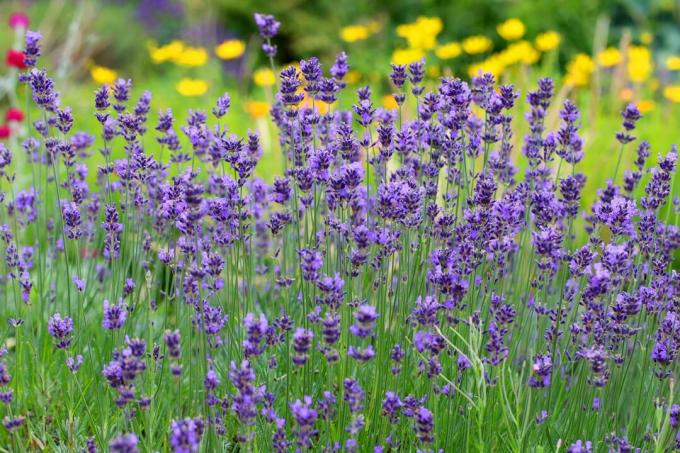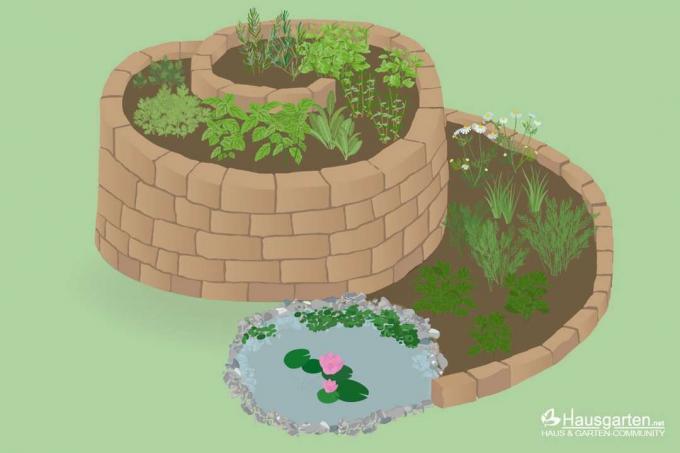

Table of contents
- Harvest on time
- in the air
- In the dehydrator
- In the oven
- Make your own spice blends
- herbs of Provence
- Italian spice mix
- soup seasoning
- Seasoned Salt
The list of kitchen herbs is long. There is the right herb for almost every dish. You can enjoy them fresh or dry them and use them to create your very own spice creations.
Harvest on time
Harvesting at the right time is important in order to preserve and use the full aroma and flavor of these aromatic plants. Many kitchen herbs develop their most intense aroma before flowering and should then be harvested as quickly as possible. As a rule, the aroma is quickly lost during flowering. Of course they are still edible. Ideally, collect them on a sunny day, once the morning dew has dried. After harvesting, they can be air dried, dried in a dehydrator, or in an oven.
in the air
Drying is the most popular and well-known method of preserving aromatic plants. However, you should never wash them, but only remove dirt by shaking them or using your hands. If you wash them, this is at the expense of the plant quality and also delays the drying process. Air drying is probably the gentlest of all drying methods, but it is also the most time-consuming.
- the first step is to clean the fresh herb
- then tie loosely into small bundles
- do not squeeze or press, hang upside down
- don't hang too close because of the ventilation
- in a warm, shady and wind-protected place
- Do not expose items to be dried to direct sunlight
- ideal ambient temperature between 20 and 30 degrees
- not warmer than 35 degrees, essential oils could volatilize
- optimal drying time between two and four days
- fully dried when the plants have a papery consistency
Unfortunately, not all kitchen herbs are suitable for this method of preservation. Types with soft leaves such as parsley, chives, basil, dill, cress or lovage are best frozen. They would lose most of their flavor during the drying process. Peppermint, rosemary, sage, thyme, savory, marjoram, oregano, lavender as well as chamomile, mugwort and woodruff are very suitable.
In the dehydrator
In the dehydrator, drying should be particularly gentle due to the low temperatures. Such devices usually work in a temperature range between 30 and 70 degrees. Consequently, it would be an advantage if the dehydrator had an appropriate temperature controller. With the right setting, the water is gently removed from the herbs and the loss of aroma is limited. Temperatures of 40 degrees are usually optimal. Many kitchen herbs are simply no longer edible at higher temperatures.
- only use intact plants for drying
- remove yellow or rotten spots
- washing the herb as opposed to air drying
- dry well with kitchen roll
- Distribute evenly on the drying grid of the dehydrator
- pay attention to sufficient distance, do not overlap
- only chop after drying
- Drying process takes about two to three hours
Tip:
Mediterranean herbs such as oregano, sage or marjoram only develop their intensive aroma, smell and taste after they have been dried.
In the oven
This method is quite expensive due to the long drying time and the associated power consumption. Here, too, the collected goods are distributed, without the plants touching each other, on a baking tray lined with baking paper and pushed into the preheated oven. At 50-60 degrees they are now dried for two to three hours. During drying, the oven door should be slightly ajar to allow moisture to escape. It's best to just stick a wooden spoon or something similar in the door.
Tip:
When drying in the oven, you usually have to reckon with a slight loss of aroma.
Make your own spice blends

herbs of Provence
- 1 tbsp rosemary
- 1 tbsp oregano
- 1 tbsp thyme
- 1 tbsp basil
- 1 tbsp savory
Depending on your needs, you can refine this mixture with bay leaves, marjoram, chervil, aniseed, fennel, tarragon, sage and/or lovage. These spices Herb mixtures go well with different dishes, including salads.
Italian spice mix
- 1 tbsp thyme
- 1 tbsp rosemary
- 1 tbsp sage
- 2 tbsp basil
- 2 tbsp oregano
This mixture can be supplemented or substituted with parsley, mint, dill or nutmeg, depending on what you like to have in it.
soup seasoning
- 2 tsp thyme
- 3 tsp parsley
- 3 tsp chives
- 4 tsp chervil
- 6 teaspoons lovage
All these herbal plants are known for their intense aroma and delicious taste. If you add celery, fresh leeks and carrots, nothing stands in the way of a delicious stew.
Seasoned Salt
- basil
- rosemary
- oregano
- sage
- thyme
The kitchen herbs mentioned are inoculated with salt Relationship 1:10 (10 g cabbage and 100 g salt) mixed. Depending on your taste and willingness to experiment, you can add lavender and mint, but only in small doses small amounts, because both spices have a very intense aroma, which easily masks that of the others could.
 garden editorial
garden editorial I write about everything that interests me in my garden.
Learn more about growing herbs

Basil has black dots: what to do?
Especially basil bought in a pot from the supermarket tends to quickly develop black dots or spots on the leaves. This article explains why this is and what helps against it.

14 kitchen herbs that you can really keep in the kitchen
Sometimes a herb garden is only possible on the windowsill. If you don't have your own garden bed, for example, or in the months when the frost freezes the coveted greenery outside. Our list provides an overview of which herbs like the kitchen location permanently.

Parsley turns yellow: Four tips against yellow leaves
If the leaves of the parsley suddenly turn yellow, the so-called parsley disease is usually behind it. This can have many causes. If the outbreak of the disease is to be prevented, only prevention helps. More about this here.

You can combine lavender with these 13 plants
Whether you use it in the kitchen, want to enjoy its fragrance or its beauty, lavender is a must in any garden. Well combined, it can strengthen other plants or protect them from pests. We present the best plant neighbors.

8 tips for cutting and harvesting herbs properly
Fresh herbs from the garden should not be missing in any kitchen. They are versatile, exude pleasant and spicy scents and are a treat for the eye with their pretty flowers. In the kitchen, they can easily replace artificial flavor enhancers.

Herb spiral & herb snail: this is how it's done
A herb spiral or herb snail makes it possible to plant many different varieties in a particularly decorative way. However, this is not the only advantage of these variants of the culture. You can find out how to create them here.
